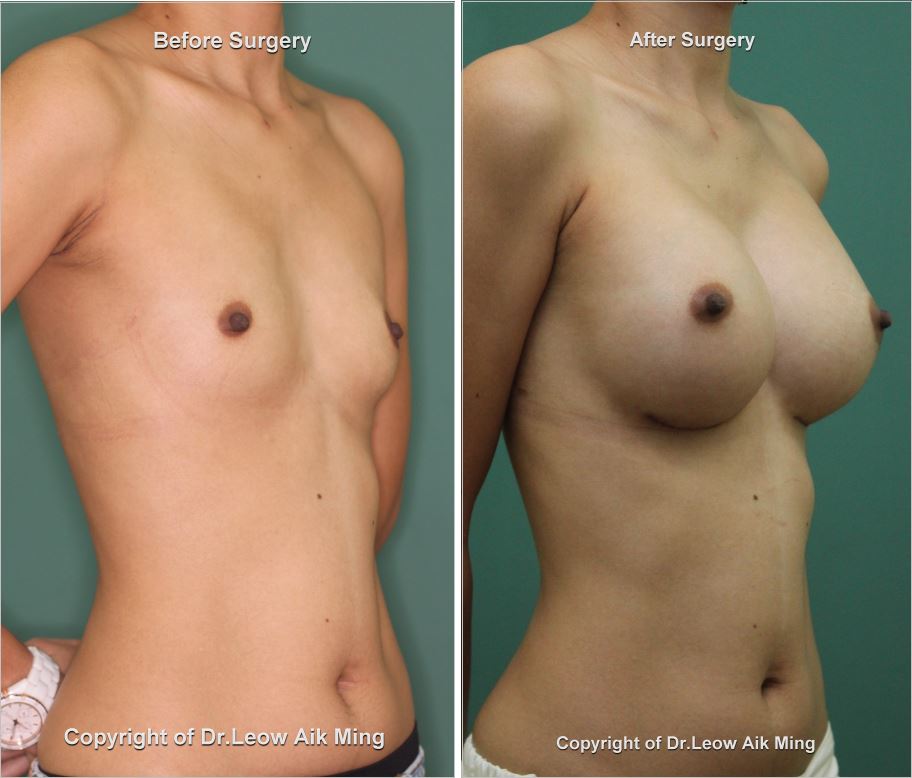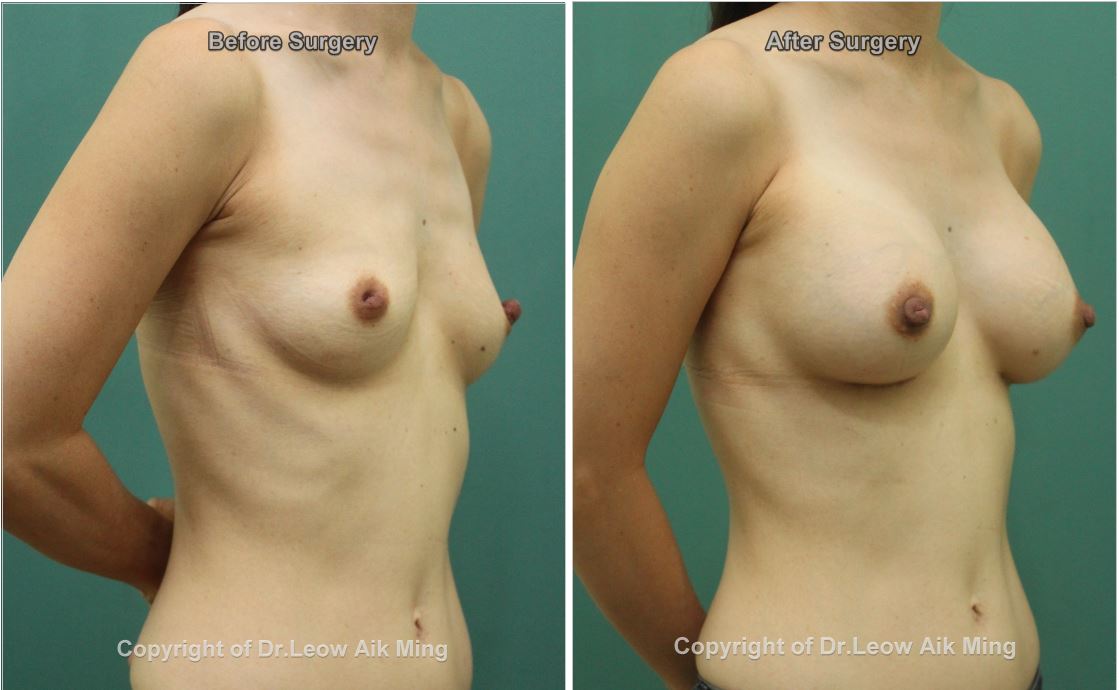Breast augmentation surgery (augmentation mammaplasty) is a cosmetic surgical procedure that involves using implants to achieve fuller breasts or to restore breast volume. Breast implants also may be used to reconstruct a breast after mastectomy for breast cancer or injury. The objectives of breast augmentation are:
- To increase fullness and projection of the breasts
- To restore a well proportionate figure
- To enhance self-image and self-confidence
Although there are several types of breast implants available in the market such as saline implants, silicone implants or polyurethane implants, silicone breast implants remain the most popular choice amongst the patients and plastic surgeons.
Depending upon the patients’ selection and choice of breast implants used, the incisions for breast augmentation can be done either through:
- Inframammary (under the bust) incision
- Transaxillary (armpit) incision
- Periareolar (around the areola) incision

Similarly, the placement of breast implants can either be:
-
- Subglandular: breast implant is placed between the breast tissue and pectoralis major muscle
- Submuscular: breast implant is placed beneath the pectoralis major muscle
- Subfacial: breast implant is placed beneath the fascia of pectoralis major muscle

Breast augmentation surgery does not correct severely drooping breasts. In conditions where the breasts are severely drooped or sagged, breast lift surgery may be required in conjunction with breast augmentation surgery.
Ideal candidates for breast augmentation surgery
- When both breasts are fully developed that vary in size or shape
- Breasts that are too small
- Loss of breast shape and volume after pregnancy, weight loss, or with ageing
- One or both breasts failed to develop normally
- Healthy individuals who do not have medical conditions that can impair healing or increase the risk of surgery
- Individuals with a positive outlook and realistic expectations
- Non-smokers
Case No 1:

Case No 2:

Preoperative evaluation for breast augmentation surgery
Communication is vital to achieving the patient’s goals. During the initial consultation, patients will have the opportunity to discuss their goals and desired results with the plastic surgeon. The plastic surgeon will work closely with the patients to reach an agreement about the expectations from the surgical procedures involved and their long term benefits. Every patient is different. Therefore a specific treatment regimen is planned to suit an individual’s need. The preoperative evaluation for breast augmentation surgery includes:
- Discussion about patients’ expectations and desired outcome
- Medical conditions, drug allergies and previous medical or surgical treatment
- Use of current medications, vitamins, herbal supplements, alcohol, tobacco and drugs
- Discussion on anaesthesia and its risks
- Physical examination including breasts
- Discussion on type and size of breast implants, location of incisional sites and other additional procedures such as breast lift
- Photography for preoperative and postoperative evaluation
Preparation for breast augmentation surgery
- Get laboratory testing or a medical evaluation
- Get a baseline mammogram before surgery and after surgery to help detect any future changes in the breast tissue
- Adjust medications for specific medical conditions
- Stop smoking and alcohol well in advance before the scheduled date for surgery
- Avoid taking aspirin, anti-inflammatory drugs and herbal supplements before surgery
- Special instructions will be given on the day before and after surgery
The risks and safety information on breast augmentation surgery
It is essential for patients to understand that every surgical procedure has its complications and downtime. However, if a patient is appropriately assessed before the surgery and postoperative care is given adequately, these risks can be eliminated or reduced.
Some of the risks of breast augmentation surgery:
- Infection
- Bleeding
- Poor wound healing
- Wound breakdown
- Skin discolouration
- Swelling due to a blood clot or fluid accumulation
- Fluid accumulation
- Scarring (hypertrophy or keloidal scar)
- Temporary numbness or changes in the skin sensation around the nipple or breast
- Capsular contracture, which is the formation of firm scar tissue around the implant
- Breast implant leakage or rupture
- Wrinkling of the skin over the implant
- Asymmetry
- Possibility of revision surgery
- Anaesthesia risks
- Immunological response
- The rare occurrence of breast implant-associated anaplastic large cell lymphoma (BIA-ALCL)
Postoperative expectations
After the surgery, temporary dressings or bandages are applied to the incision sites. Small tubes may be temporarily placed under the skin for 24-48 hours to remove any excess blood or fluid that may be collected after the surgery. During the first 2-3 days, there may be discomfort, swelling, bruises and tightness around the breasts. Once the tubes and temporary dressings are removed, the patient is advised to wear a sports bra (for 4-6 weeks) to minimise the swelling and support the breasts during the healing phase. It is advisable to avoid strenuous activities such as heavy weight lifting or vigorous exercise for the first 7-10 days after the surgery. Light physical and social activities can be resumed from the 4th day after the surgery. Oral antibiotics and analgesics will be prescribed to reduce the risk of infection and postoperative pain respectively. Stitches will be removed 7-10 days after the surgery. The symptoms of discomfort, swelling, bruises and tightness around the breasts may disappear completely about 2-3 weeks after the surgery, but the breasts may gradually take several months or a year to soften and feel more natural.
Postoperative care
- Regular application of antibiotic ointment and cleaning the operated areas for the first one week after the surgery
- Bed rest with arms elevated to reduce swelling
- Avoid excessive arm movement or weight lifting for the first 7-10 days after surgery
- Arm movement should be limited for up to 1-2 weeks following the surgery
- Wear sports bra (no underwire bra) for 4-6 weeks after the surgery
- Regular use of scar gel and massage after the surgery to improve the scar and breast shape
Other important considerations:
- Breast implants are not guaranteed to last a lifetime, and future surgery may be required to replace one or both implants
- Pregnancy, weight loss and menopause may influence the appearance of augmented breasts with time
- Breast augmentation requires regular breast examinations and to evaluate the condition of the breast implants
How much will a breast augmentation surgery cost?
Cost is always a consideration in elective surgery. The cost of breast augmentation can vary widely.
The cost of breast augmentation surgery may include:
- Surgeon’s fee
- Hospital or surgical facility costs
- Anaesthesia fees
- Medical tests and x-rays
- Breast implants
- Prescriptions for medication
Breast augmentation surgery is a cosmetic surgical procedure. Most of the health insurance companies do not cover cosmetic surgeries or their complications.
